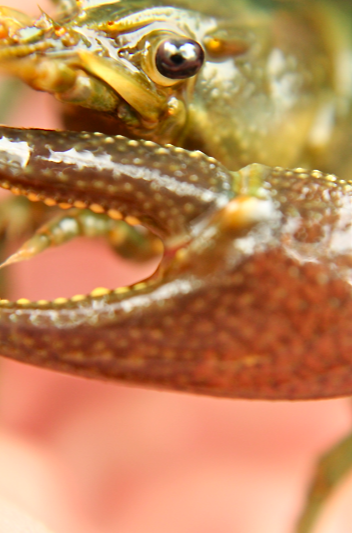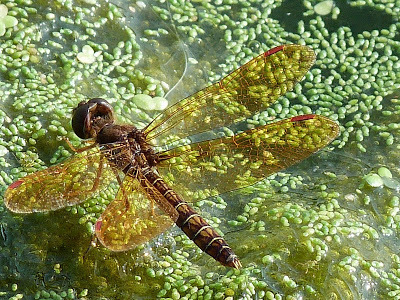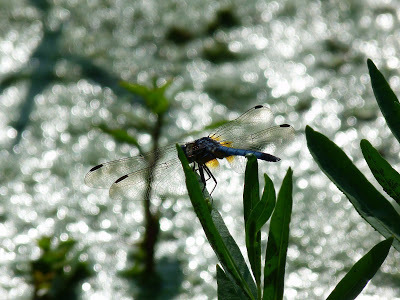Gordon Grice's Blog, page 74
November 20, 2011
Video: Spider Monkeys vs. Drunk
Video: Drunk zoo visitor attacked by monkeys - Telegraph:
"Joao Leite Dos Santos, a mechanic from Sao Paulo, decided it would be fun to join a colony of spider monkeys in their enclosure to see if they wanted to play.
After climbing the fence he waded across the dividing pool where a group of the primates gathered on the bank. Thinking that they were inviting him to join them, Mr Dos Santos reached out to touch them. But [one of] the fiercely territorial monkeys bit his wrist, while another bit and clawed his elbow and shoulder."
Dos Santos has admitted to drinking before his adventure.

"Joao Leite Dos Santos, a mechanic from Sao Paulo, decided it would be fun to join a colony of spider monkeys in their enclosure to see if they wanted to play.
After climbing the fence he waded across the dividing pool where a group of the primates gathered on the bank. Thinking that they were inviting him to join them, Mr Dos Santos reached out to touch them. But [one of] the fiercely territorial monkeys bit his wrist, while another bit and clawed his elbow and shoulder."
Dos Santos has admitted to drinking before his adventure.
Published on November 20, 2011 09:00
November 19, 2011
The Importance of Alpo
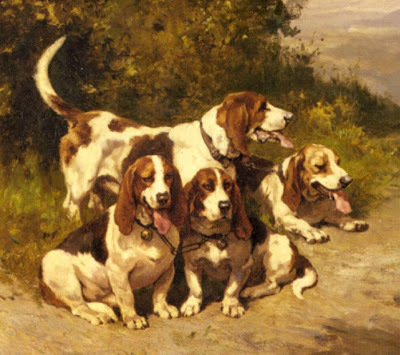
Starved Dogs Devour Owner
Interesting news report from Indonesia:
A neighborhood guard was curious when he saw luggage lined up at the front of Andre Lumboga's house, days after the 50-year old arrived back home. He approached the house, smelled something foul and called the police, according to a report.
"His skull was found in the kitchen, and his body was found in the front of his house," Eriyana, a local police chief in Batam, an island off Sumatra, told VIVAnews website.
Thanks to Faye for the news tip.
Published on November 19, 2011 09:00
November 18, 2011
Crawdad
Published on November 18, 2011 09:00
November 17, 2011
Documentaries on Exotic Animals in the US
This documentary, The Elephant in the Living Room, sounds interesting. Anybody seen it?
Another film with similar concerns is The Tiger Next Door. I haven't seen it yet either. (Thanks to Jay for putting me onto this one.)

Another film with similar concerns is The Tiger Next Door. I haven't seen it yet either. (Thanks to Jay for putting me onto this one.)
Published on November 17, 2011 09:00
November 16, 2011
Pet Hippo Kills Owner

South African farmer killed by pet hippopotamus - Telegraph:
"Marius Els, 41, was attacked by Humphrey on Saturday night. The farmer's mutilated body was discovered submerged in a river running through his 400 acres in rural South Africa.
Earlier this year Mr Els was pictured happily riding on his pet bull hippo's back.
'Humphrey's like a son to me, he's just like a human,' he said at the time.
'There's a relationship between me and Humphrey and that's what some people don't understand.'"
Published on November 16, 2011 09:00
November 15, 2011
Weird Deer: The Beautiful and the Damned, Part 2
Dee's day at La Cygne wasn't all so disturbing. She also photographed this white deer. There are "ghost deer" in Wisconsin, and a whole herd in New York state, but I didn't know about any in Kansas. The Wisconsin and New York ghosts are simply variants of the native white-tailed deer.
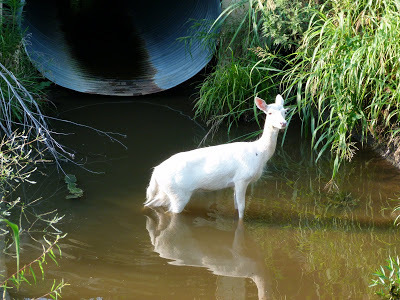
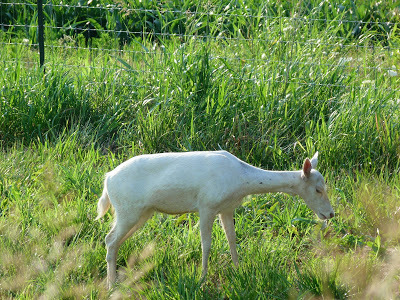
I asked the Kansas Department of Wildlife and Parks about this unusual animal, and the biologists there were concerned. They identified this as a fallow deer, which is native to Europe and Asia. White is one of several common colors for the fallow deer. Invasive species can wreak havoc with an ecosystem; in Georgia, for example, imported fallow deer damage the trees -- and all the organisms that depend on them. So the biologists weren't pleased to see this one loose in a state conservation area. Dee was able to help them locate the farm this privately owned deer escaped from. It's been returned.
Photography by Dee Puett*
White Deer of New York:



I asked the Kansas Department of Wildlife and Parks about this unusual animal, and the biologists there were concerned. They identified this as a fallow deer, which is native to Europe and Asia. White is one of several common colors for the fallow deer. Invasive species can wreak havoc with an ecosystem; in Georgia, for example, imported fallow deer damage the trees -- and all the organisms that depend on them. So the biologists weren't pleased to see this one loose in a state conservation area. Dee was able to help them locate the farm this privately owned deer escaped from. It's been returned.
Photography by Dee Puett*
White Deer of New York:
Published on November 15, 2011 09:00
November 14, 2011
Weird Deer: The Beautiful and the Damned, Part 1
At the La Cygne conservation area in Kansas, my correspondent Dee Puett photographed some unusual deer. First, there's this mangy-looking doe:
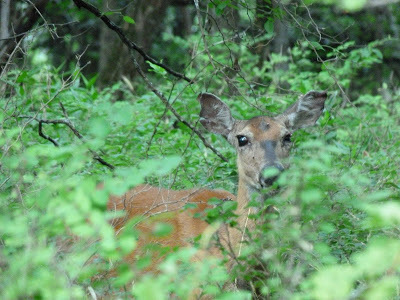
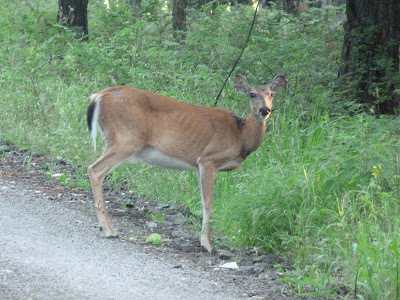
The whole herd looked small, and many had scabs like the ones on this doe's face and neck. Dee fears that unhealthy appearance could be a sign of chronic wasting disease. Deer afflicted with CWD lose weight, develop odd neurological symptoms (like drooling and walking in circles), and eventually die.
CWD is one of an unusual group of diseases called "transmissible spongiform encephalopathies," caused by prions. A prion is a molecule of a normal brain protein bent into an abnormal shape. In the central nervous system of a mammal, it converts its fellows to its own shape. These malcontent molecules stop doing their work and cause neurons to fracture and die. At an autopsy, the brain tissue of one so affected is spongy, full of cavities, as if blasted with birdshot.
It appears that most people are immune, or at least genetically inclined toward resistance. The rare infection is glacial, taking years or even decades to make itself apparent. Once it does manifest, the victim has only a few months to live. His nervous system will gradually fail. The first signs in humans are clumsiness, tremors, and slurred speech. Next may come bizarre laughter, mood swings, dementia, and uncontrollable movements, as if he were occasionally receiving an electric shock. Finally the body stops responding to the mind; incontinence, paralysis, coma, and—inevitably—death ensue.
Prions can occur because of a mutant gene, which may kill the possessor and his children. In another scenario, a person may spontaneously develop prion infection—a brief quirk of his biochemistry leads, years later, to his death. The third way to get a prion disease is by contamination: surgical instruments, grafts, and even human growth hormone have transmitted the infection from one human to another. The Fore people of New Guinea used to pass a spongiform disease called kuru by eating their own dead. (Among the world's diverse cultures, cannibalism of one sort of another is not an especially unusual funerary practice.)
Eating other animals is another way to get infected. People have known scrapie, the prion disease of sheep and goats, for centuries, though it does not seem to pass directly to humans. But a change in rendering methods may have caused this infection to pass to cattle, where it manifested as the notorious mad cow disease, known to scientists as bovine spongiform encephalopathy. Hundreds of thousands of domestic cattle fell to this disease in the 1980s and 90s; the practice of turning cattle organ meat into food for other cattle magnified the incidence of the otherwise rare disease. More than 130 cases passed from cattle to human consumers. In the human victims, this particular prion disease is called variant Creutzfeldt-Jakob disease.
Various spongiform diseases have turned up in other animals—minks, deer, antelope, cats. So far, there is little to suggest that these pose any danger to humans. Some doctors have proposed that eating squirrel brains can cause a spongiform disease, but solid evidence of this has not yet appeared. The widespread occurrence of CWD in North America—it's been found in a dozen US states and two Canadian provinces, in moose, elk, white-tailed deer, and mule deer—raises the question of whether people can get sick from eating the venison. So far, we don't know.
Meanwhile, my correspondent D'Arcy Allison-Teasley spotted this deer in her own yard early one morning. (It looks hazy because there wasn't much light yet.) D'Arcy noted the odd growths on the deer. Our Wisconsin DNR told her this viral fibromatosis is not especially harmful to the deer, but I wonder whether it affects their chances of getting a date to the spring cotillion.
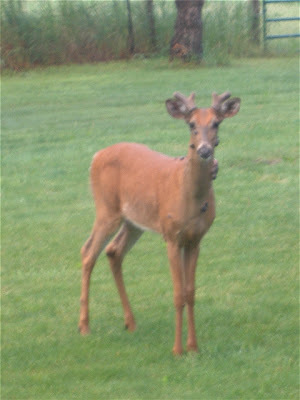
I'd like to hope that this disease, or something equally minor, is behind the unhealthy appearance of the Kansas deer.
Next: Ghost Deer


The whole herd looked small, and many had scabs like the ones on this doe's face and neck. Dee fears that unhealthy appearance could be a sign of chronic wasting disease. Deer afflicted with CWD lose weight, develop odd neurological symptoms (like drooling and walking in circles), and eventually die.
CWD is one of an unusual group of diseases called "transmissible spongiform encephalopathies," caused by prions. A prion is a molecule of a normal brain protein bent into an abnormal shape. In the central nervous system of a mammal, it converts its fellows to its own shape. These malcontent molecules stop doing their work and cause neurons to fracture and die. At an autopsy, the brain tissue of one so affected is spongy, full of cavities, as if blasted with birdshot.
It appears that most people are immune, or at least genetically inclined toward resistance. The rare infection is glacial, taking years or even decades to make itself apparent. Once it does manifest, the victim has only a few months to live. His nervous system will gradually fail. The first signs in humans are clumsiness, tremors, and slurred speech. Next may come bizarre laughter, mood swings, dementia, and uncontrollable movements, as if he were occasionally receiving an electric shock. Finally the body stops responding to the mind; incontinence, paralysis, coma, and—inevitably—death ensue.
Prions can occur because of a mutant gene, which may kill the possessor and his children. In another scenario, a person may spontaneously develop prion infection—a brief quirk of his biochemistry leads, years later, to his death. The third way to get a prion disease is by contamination: surgical instruments, grafts, and even human growth hormone have transmitted the infection from one human to another. The Fore people of New Guinea used to pass a spongiform disease called kuru by eating their own dead. (Among the world's diverse cultures, cannibalism of one sort of another is not an especially unusual funerary practice.)
Eating other animals is another way to get infected. People have known scrapie, the prion disease of sheep and goats, for centuries, though it does not seem to pass directly to humans. But a change in rendering methods may have caused this infection to pass to cattle, where it manifested as the notorious mad cow disease, known to scientists as bovine spongiform encephalopathy. Hundreds of thousands of domestic cattle fell to this disease in the 1980s and 90s; the practice of turning cattle organ meat into food for other cattle magnified the incidence of the otherwise rare disease. More than 130 cases passed from cattle to human consumers. In the human victims, this particular prion disease is called variant Creutzfeldt-Jakob disease.
Various spongiform diseases have turned up in other animals—minks, deer, antelope, cats. So far, there is little to suggest that these pose any danger to humans. Some doctors have proposed that eating squirrel brains can cause a spongiform disease, but solid evidence of this has not yet appeared. The widespread occurrence of CWD in North America—it's been found in a dozen US states and two Canadian provinces, in moose, elk, white-tailed deer, and mule deer—raises the question of whether people can get sick from eating the venison. So far, we don't know.
Meanwhile, my correspondent D'Arcy Allison-Teasley spotted this deer in her own yard early one morning. (It looks hazy because there wasn't much light yet.) D'Arcy noted the odd growths on the deer. Our Wisconsin DNR told her this viral fibromatosis is not especially harmful to the deer, but I wonder whether it affects their chances of getting a date to the spring cotillion.

I'd like to hope that this disease, or something equally minor, is behind the unhealthy appearance of the Kansas deer.
Next: Ghost Deer
Published on November 14, 2011 09:00
November 12, 2011
More Dragonflies
Published on November 12, 2011 09:03
November 11, 2011
Fishing Cat: New Uses for Your Bathtub
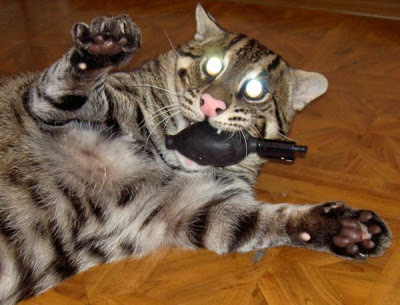
Near Lucknow, Uttar Predesh, India in 2009, some sort of feline was responsible for a series of attacks on humans. Some theorized the culprit was a leopard; others blamed a fishing cat.
The fishing cat, as you'll see in these photos, is a beautifully patterned animal about twice the size of a house cat. My correspondent Croconut tells me there are other reports of fishing cats snatching children in Southeast Asia. Beacham's Guide to International Endangered Species says they are "ferocious and dangerous. Even for Felidae, fishing cats are especially powerful and are known to be able to drive off a pack of dogs; one in captivity broke out of its enclosure into one holding a female leopard and killed the leopard, which was twice its size. They can do significant harm to humans or other large animals they deem threatening."
Croconut also pointed me to these fascinating photos of a fishing cat kept as a pet by a Russian family. The link has more.
Хуясе КОТИК (PHOTO) - 10 Февраля 2008 - Здесь всё что Вам нужно!:

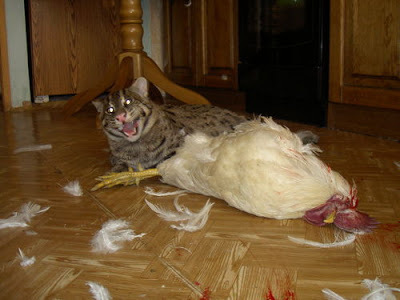
Published on November 11, 2011 09:09
November 10, 2011
Metamorphosis of a Monarch
 We caught a couple of monarch butterfly caterpillars and put them in a cage.
We caught a couple of monarch butterfly caterpillars and put them in a cage.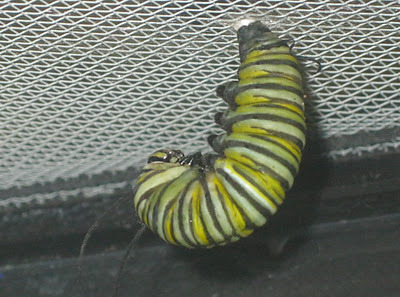 After a few days, they hung themselves by the tails and curled up.
After a few days, they hung themselves by the tails and curled up. At first the chrysalises they spun were green with gold trim.
At first the chrysalises they spun were green with gold trim. Soon, we could see the butterflies' colors showing through.
Soon, we could see the butterflies' colors showing through. Each chrysalis grew dark.
Each chrysalis grew dark. It became easy to see the precise pattern of the butterflies' wings.
It became easy to see the precise pattern of the butterflies' wings. They emerged with crumpled wings.
They emerged with crumpled wings.
 . . . but the wings soon straightened.
. . . but the wings soon straightened.
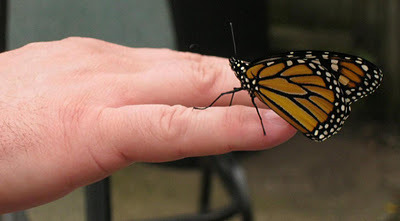 When we released them, this one crawled onto my hand, looking for a higher spot to fly from.
When we released them, this one crawled onto my hand, looking for a higher spot to fly from. It landed in a pine tree before flying away for good.
It landed in a pine tree before flying away for good. Photography by Parker Grice
Published on November 10, 2011 09:00



